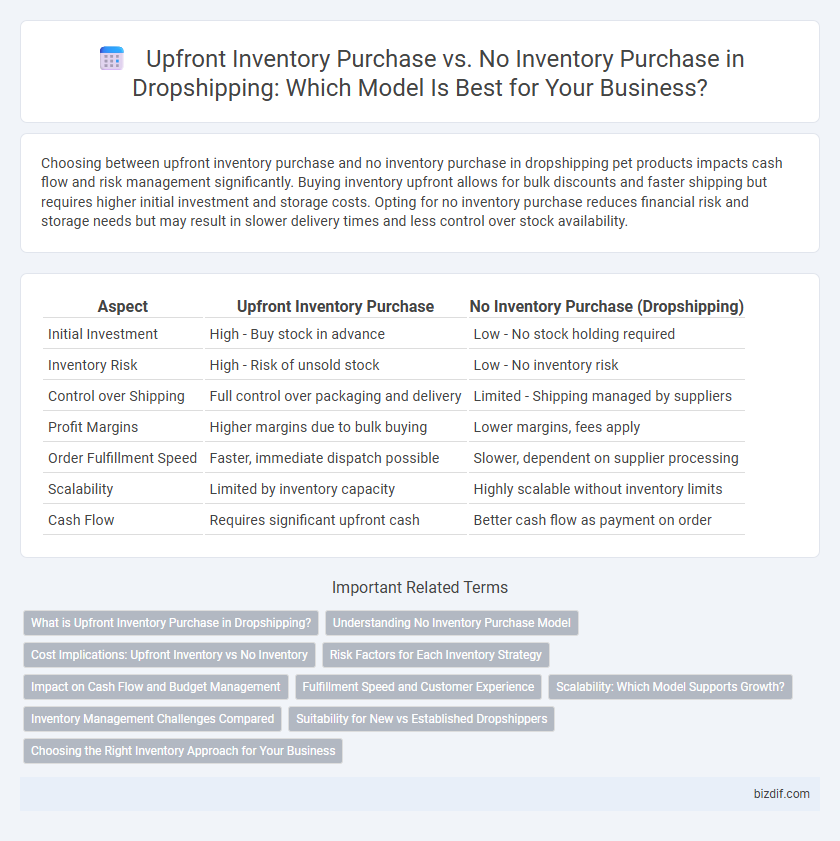Choosing between upfront inventory purchase and no inventory purchase in dropshipping pet products impacts cash flow and risk management significantly. Buying inventory upfront allows for bulk discounts and faster shipping but requires higher initial investment and storage costs. Opting for no inventory purchase reduces financial risk and storage needs but may result in slower delivery times and less control over stock availability.
Table of Comparison
| Aspect | Upfront Inventory Purchase | No Inventory Purchase (Dropshipping) |
|---|---|---|
| Initial Investment | High - Buy stock in advance | Low - No stock holding required |
| Inventory Risk | High - Risk of unsold stock | Low - No inventory risk |
| Control over Shipping | Full control over packaging and delivery | Limited - Shipping managed by suppliers |
| Profit Margins | Higher margins due to bulk buying | Lower margins, fees apply |
| Order Fulfillment Speed | Faster, immediate dispatch possible | Slower, dependent on supplier processing |
| Scalability | Limited by inventory capacity | Highly scalable without inventory limits |
| Cash Flow | Requires significant upfront cash | Better cash flow as payment on order |
What is Upfront Inventory Purchase in Dropshipping?
Upfront inventory purchase in dropshipping involves buying products in bulk from suppliers before selling them to customers, allowing greater control over stock availability and potentially better profit margins. This approach requires significant initial investment and storage capacity but reduces dependency on suppliers' stock fluctuations. Businesses using upfront inventory purchase can ensure faster shipping times and enhanced product quality verification compared to traditional dropshipping models without inventory purchase.
Understanding No Inventory Purchase Model
The no inventory purchase model in dropshipping eliminates the need for upfront stock investment, allowing sellers to list products without holding physical inventory. This approach reduces financial risk and operational costs since products are sourced directly from suppliers only after a customer places an order. Efficient supplier integration and real-time inventory tracking are crucial for maintaining product availability and customer satisfaction in the no inventory purchase model.
Cost Implications: Upfront Inventory vs No Inventory
Upfront inventory purchase in dropshipping requires significant initial capital investment, increasing financial risk if products do not sell quickly, but often allows for better wholesale pricing and higher profit margins per unit. No inventory purchase eliminates storage and holding costs, minimizing initial expenses and reducing financial risk by only paying for products after customer orders, though this typically results in lower profit margins due to higher per-unit costs from suppliers. Businesses must balance upfront investment costs, cash flow implications, and profitability when choosing between inventory models to optimize cost efficiency and scalability.
Risk Factors for Each Inventory Strategy
Upfront inventory purchase carries the risk of overstocking, leading to increased storage costs and potential losses if products do not sell as expected. No inventory purchase minimizes financial risk by eliminating the need for upfront capital, but exposes sellers to supplier reliability issues and longer shipping times, which can harm customer satisfaction. Both strategies require careful supplier evaluation and market demand analysis to mitigate financial and operational risks effectively.
Impact on Cash Flow and Budget Management
Upfront inventory purchase in dropshipping requires significant capital investment, tying up cash flow and increasing financial risk due to unsold stock. No inventory purchase models improve cash flow flexibility by only buying products after receiving customer orders, reducing upfront costs and budget constraints. Efficient cash flow management favors no inventory purchase, enabling better allocation of funds toward marketing and operational expenses.
Fulfillment Speed and Customer Experience
Upfront inventory purchase enables faster fulfillment by having products ready to ship immediately, significantly enhancing customer experience through reduced delivery times. In contrast, no inventory purchase relies on suppliers to fulfill orders after they are placed, often resulting in longer shipping durations and potential delays. Faster fulfillment directly correlates with higher customer satisfaction and repeat business in dropshipping models.
Scalability: Which Model Supports Growth?
No inventory purchase dropshipping offers greater scalability by minimizing upfront costs and allowing sellers to test multiple product niches without financial risk. In contrast, upfront inventory purchase demands significant capital investment and limits flexibility, potentially hindering rapid expansion. Therefore, dropshipping with no inventory purchase supports faster growth and adaptability in fluctuating markets.
Inventory Management Challenges Compared
Upfront inventory purchase in dropshipping requires significant capital investment and risks overstocking or stockouts, complicating inventory management with the need for accurate demand forecasting and storage solutions. No inventory purchase dropshipping eliminates storage costs and reduces financial risk but poses challenges in supplier reliability and real-time inventory synchronization, increasing the likelihood of order fulfillment issues. Effective inventory management balances transparency, supplier communication, and technology integration to optimize stock levels and ensure seamless order processing.
Suitability for New vs Established Dropshippers
New dropshippers often benefit from no inventory purchase models due to lower financial risk and easier market testing. Established dropshippers may prefer upfront inventory purchase for better control over stock quality, faster shipping, and higher profit margins. Choosing between these approaches depends on experience level, capital availability, and desired operational control in the dropshipping business.
Choosing the Right Inventory Approach for Your Business
Selecting the right inventory approach in dropshipping hinges on your business model's scale and cash flow capacity. Upfront inventory purchase offers greater control over stock quality and fulfillment speed but requires significant initial investment and storage management. Conversely, no inventory purchase minimizes financial risk and allows flexibility, relying on supplier availability and potentially longer delivery times.
Upfront Inventory Purchase vs No Inventory Purchase Infographic

 bizdif.com
bizdif.com